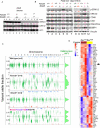TGFβ pathway is required for viable gestation of Fanconi anemia embryos
- PMID: 36441774
- PMCID: PMC9731498
- DOI: 10.1371/journal.pgen.1010459
TGFβ pathway is required for viable gestation of Fanconi anemia embryos
Abstract
Overexpression of the TGFβ pathway impairs the proliferation of the hematopoietic stem and progenitor cells (HSPCs) pool in Fanconi anemia (FA). TGFβ promotes the expression of NHEJ genes, known to function in a low-fidelity DNA repair pathway, and pharmacological inhibition of TGFβ signaling rescues FA HSPCs. Here, we demonstrate that genetic disruption of Smad3, a transducer of the canonical TGFβ pathway, modifies the phenotype of FA mouse models deficient for Fancd2. We observed that the TGFβ and NHEJ pathway genes are overexpressed during the embryogenesis of Fancd2-/- mice and that the Fancd2-/-Smad3-/- double knockout (DKO) mice undergo high levels of embryonic lethality due to loss of the TGFβ-NHEJ axis. Fancd2-deficient embryos acquire extensive genomic instability during gestation which is not reversed by Smad3 inactivation. Strikingly, the few DKO survivors have activated the non-canonical TGFβ-ERK pathway, ensuring expression of NHEJ genes during embryogenesis and improved survival. Activation of the TGFβ-NHEJ axis was critical for the survival of the few Fancd2-/-Smad3-/- DKO newborn mice but had detrimental consequences for these surviving mice, such as enhanced genomic instability and ineffective hematopoiesis.
Copyright: © 2022 Rodríguez et al. This is an open access article distributed under the terms of the Creative Commons Attribution License, which permits unrestricted use, distribution, and reproduction in any medium, provided the original author and source are credited.
Conflict of interest statement
I have read the journal’s policy and the authors of this manuscript have the following competing interests: A.D. D’Andrea is a consultant/advisory board member for Lilly Oncology, Merck-EMD Serono, Intellia Therapeutics, Sierra Oncology, Cyteir Therapeutics, Third Rock Ventures, AstraZeneca, Ideaya Inc., Cedilla Therapeutics Inc., a stockholder in Ideaya Inc., Cedilla Therapeutics Inc., and Cyteir, and reports receiving commercial research grants from Lilly Oncology and Merck-EMD Serono.
Figures





Similar articles
-
The non-homologous end-joining activity is required for Fanconi anemia fetal HSC maintenance.Stem Cell Res Ther. 2019 Mar 29;10(1):114. doi: 10.1186/s13287-019-1206-0. Stem Cell Res Ther. 2019. PMID: 30925933 Free PMC article.
-
Inactivation of murine Usp1 results in genomic instability and a Fanconi anemia phenotype.Dev Cell. 2009 Feb;16(2):314-20. doi: 10.1016/j.devcel.2009.01.001. Dev Cell. 2009. PMID: 19217432 Free PMC article.
-
Inhibition of TGFβ1 and TGFβ3 promotes hematopoiesis in Fanconi anemia.Exp Hematol. 2021 Jan;93:70-84.e4. doi: 10.1016/j.exphem.2020.11.002. Epub 2020 Nov 7. Exp Hematol. 2021. PMID: 33166613 Free PMC article.
-
Fanconi anemia: causes and consequences of genetic instability.Genome Dyn. 2006;1:218-242. doi: 10.1159/000092510. Genome Dyn. 2006. PMID: 18724063 Review.
-
Current knowledge on the pathophysiology of Fanconi anemia: from genes to phenotypes.Int J Hematol. 2001 Jul;74(1):33-41. doi: 10.1007/BF02982547. Int J Hematol. 2001. PMID: 11530803 Review.
Cited by
-
Chemical Carcinogen (3-Methylcholanthrene)-induced Pleomorphic Rhabdomyosarcomas in Fanconi Anemia Fancd2-/-, Fancg-/- (C57BL/6), Fancd2-/- (129/Sv) Mice.In Vivo. 2024 Nov-Dec;38(6):2582-2590. doi: 10.21873/invivo.13734. In Vivo. 2024. PMID: 39477388 Free PMC article.
-
Deregulated protein homeostasis constrains fetal hematopoietic stem cell pool expansion in Fanconi anemia.Nat Commun. 2024 Feb 29;15(1):1852. doi: 10.1038/s41467-024-46159-1. Nat Commun. 2024. PMID: 38424108 Free PMC article.
-
Chemical Carcinogen (Dimethyl-benzanthracene) Induced Transplantable Cancer in Fanconi Anemia (Fanca-/-) Mice.In Vivo. 2023 Nov-Dec;37(6):2421-2432. doi: 10.21873/invivo.13347. In Vivo. 2023. PMID: 37905617 Free PMC article.
-
SARS-CoV-2 Spike Protein Induces Oxidative Stress and Senescence in Mouse and Human Lung.In Vivo. 2024 Jul-Aug;38(4):1546-1556. doi: 10.21873/invivo.13605. In Vivo. 2024. PMID: 38936937 Free PMC article.
References
-
- Pontel LB, Rosado IV, Burgos-Barragan G, Garaycoechea JI, Yu R, Arends MJ, et al.. Endogenous Formaldehyde Is a Hematopoietic Stem Cell Genotoxin and Metabolic Carcinogen. Mol Cell. 2015;60(1):177–88. Epub 2015/09/29. doi: 10.1016/j.molcel.2015.08.020 ; PubMed Central PMCID: PMC4595711. - DOI - PMC - PubMed
-
- Ceccaldi R, Parmar K, Mouly E, Delord M, Kim JM, Regairaz M, et al.. Bone marrow failure in Fanconi anemia is triggered by an exacerbated p53/p21 DNA damage response that impairs hematopoietic stem and progenitor cells. Cell Stem Cell. 2012;11(1):36–49. doi: 10.1016/j.stem.2012.05.013 . - DOI - PMC - PubMed
Publication types
MeSH terms
Substances
Grants and funding
LinkOut - more resources
Full Text Sources
Molecular Biology Databases
Miscellaneous

